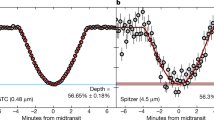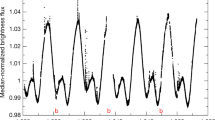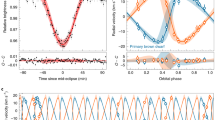Abstract
Studies1,2 have shown that the remnants of destroyed planets and debris-disk planetesimals can survive the volatile evolution of their host stars into white dwarfs3,4, but few intact planetary bodies around white dwarfs have been detected5,6,7,8. Simulations predict9,10,11 that planets in Jupiter-like orbits around stars of ≲8 M☉ (solar mass) avoid being destroyed by the strong tidal forces of their stellar host, but as yet, there has been no observational confirmation of such a survivor. Here we report the non-detection of a main-sequence lens star in the microlensing event MOA-2010-BLG-477Lb12 using near-infrared observations from the Keck Observatory. We determine that this system contains a 0.53 ± 0.11 M☉ white-dwarf host orbited by a 1.4 ± 0.3 Jupiter-mass planet with a separation on the plane of the sky of 2.8 ± 0.5 astronomical units, which implies a semi-major axis larger than this. This system is evidence that planets around white dwarfs can survive the giant and asymptotic giant phases of their host’s evolution, and supports the prediction that more than half of white dwarfs have Jovian planetary companions13. Located at approximately 2.0 kiloparsecs towards the centre of our Galaxy, it is likely to represent an analogue to the end stages of the Sun and Jupiter in our own Solar System.
This is a preview of subscription content, access via your institution
Access options
Access Nature and 54 other Nature Portfolio journals
Get Nature+, our best-value online-access subscription
$29.99 / 30 days
cancel any time
Subscribe to this journal
Receive 51 print issues and online access
$199.00 per year
only $3.90 per issue
Buy this article
- Purchase on Springer Link
- Instant access to full article PDF
Prices may be subject to local taxes which are calculated during checkout



Similar content being viewed by others
Data availability
The Keck Observatory data used in this study are freely available in the Keck Observatory Archive (https://koa.ipac.caltech.edu/cgi-bin/KOA/nph-KOAlogin). Data from the VISTA Variables in the Via Lactea (VVV) survey are available in the European Southern Observatory archive (http://archive.eso.org/wdb/wdb/adp/phase3_main/form?phase3_collection=VVV&release_tag=6). Data used to model the light curve are available from the corresponding author upon reasonable request.
Code availability
The Keck pipeline is available on GitHub (https://github.com/blackmanjw/KeckPipeline). The Bayesian analysis code of D.P.B. uses routines from ref. 42, which are subject to restricted availability.
References
Vanderburg, A. et al. A disintegrating minor planet transiting a white dwarf. Nature 526, 546–549 (2015).
Manser, C. J. et al. A planetesimal orbiting within the debris disc around a white dwarf star. Science 364, 66–69 (2019).
Villaver, E. & Livio, M. Can planets survive stellar evolution? Astrophys. J. 661, 1192–1201 (2007).
Duncan, M. J. & Lissauer, J. J. The effects of post-main-sequence solar mass loss on the stability of our planetary system. Icarus 134, 303–310 (1998).
Sigurdsson, S. et al. A young white dwarf companion to pulsar B1620-26: evidence for early planet formation. Science 301, 193–196 (2003).
Vanderburg, A. et al. A giant planet candidate transiting a white dwarf. Nature 585, 363–367 (2020).
Luhman, K. L., Burgasser, A. J. & Bochanski, J. J. Discovery of a candidate for the coolest known brown dwarf. Astrophys. J. Lett. 730, L9 (2011).
Gaensicke, B. T. et al. Accretion of a giant planet onto a white dwarf. Nature 576, 61–64 (2019).
Madappatt, N., De Marco, O. & Villaver, E. The effect of tides on the population of PN from interacting binaries. Mon. Not. R. Astron. Soc. 463, 1040–1056 (2016).
Mustill, A. J. et al. Unstable low-mass planetary systems as drivers of white dwarf pollution. Mon. Not. R. Astron. Soc. 476, 3939–3955 (2018).
Nordhaus, J. & Spiegel, D. S. On the orbits of low-mass companions to white dwarfs and the fates of the known exoplanets. Mon. Not. R. Astron. Soc. 432, 500–505 (2013).
Bachelet, E. et al. MOA 2010-blg-477lb: constraining the mass of a microlensing planet from microlensing parallax, orbital motion, and detection of blended light. Astrophys. J. 754, 73 (2012).
Schreiber, M. R. et al. Cold giant planets evaporated by hot white dwarfs. Astrophys. J. Lett. 887, L4 (2019).
Bennett, D. P. & Rhie, S. H. Detecting Earth-mass planets with gravitational microlensing. Astrophys. J. 472, 660–664 (1996).
Boyajian, T. S. et al. Stellar diameters and temperatures. III. Main sequence A, F, G, and K stars: additional high-precision measurements and empirical relations. Astrophys. J. 771, 40 (2014); erratum 787, 92 (2014).
Gaudi, B. S. Microlensing surveys for exoplanets. Annu. Rev. Astron. Astr. 50, 411–453 (2012).
Bennett, D. P. et al. MOA-2011-BLG-262Lb: a sub-Earth-mass moon orbiting a gas giant primary or a high velocity planetary system in the galactic bulge. Astrophys. J. 785, 155 (2014).
Giammichele, N., Bergeron, P. & Dufour, P. Know your neighborhood: a detailed model atmosphere analysis of nearby white dwarfs. Astrophys. J. Suppl. S. 199, 29 (2012).
Toonen, S., Hollands, M., Gänsicke, B. T. & Boekholt, T. The binarity of the local white dwarf population. Astron. Astrophys. 602, 16 (2017).
Tremblay, P. E. et al. The field white dwarf mass distribution. Mon. Not. R. Astron. Soc. 461, 2100–2114 (2016).
Veras, D. Post-main-sequence planetary system evolution. R. Soc. Open Sci. 3, 150571 (2016).
Mustill, A. J. & Villaver, E. Foretellings of Ragnarök: world-engulfing asymptotic giants and the inheritance of white dwarfs. Astrophys. J. 761, 121 (2012).
Ghezzi, L., Montet, B. T. & Johnson, J. A. Retired A stars revisited: an updated giant planet occurrence rate as a function of stellar metallicity and mass. Astrophys. J. 860, 109 (2018).
Vandorou, A. et al. Revisiting MOA 2013-BLG-220L: a solar-type star with a cold super-Jupiter companion. Astron. J. 160, 121 (2020).
OGLE Extinction Calculator. http://ogle.astrouw.edu.pl/cgi-ogle/getext.py (2013).
Nataf, D. M. et al. Reddening and extinction toward the galactic bulge from OGLE-III: the Inner Milky Way’s RV ~ 2.5 extinction curve. Astrophys. J. 769, 88 (2013).
Blackman, J. W. et al. Confirmation of the stellar binary microlensing event, Macho 97-BLG-28. Astrophys. J. 890, 87 (2020).
Beaulieu, J.-P. et al. Revisiting the microlensing event Ogle 2012-Blg-0026: a solar mass star with two cold giant planets. Astrophys. J. 824, 83 (2016).
Bertin, E. SWarp: resampling and co-adding FITS images together. Astrophysics Source Code Library record no. ascl:1010.068 (2010).
Bertin, E. & Arnouts, S. SExtractor: software for source extraction. Astron. Astrophys. Sup. 117, 393–404 (1996).
Minniti, D. et al. VISTA Variables in the Via Lactea (VVV): the public ESO near-IR variability survey of the Milky Way. New Astron. 15, 433–443 (2010).
Bennett, D. P. et al. Planetary and other short binary microlensing events from the MOA short-event analysis. Astrophys. J. 757, 119 (2012).
Bond, I. A. et al. The lowest mass ratio planetary microlens: OGLE 2016–BLG–1195Lb. Mon. Not. R. Astron. Soc. 469, 2434–2440 (2017).
Bhattacharya, A. et al. WFIRST exoplanet mass-measurement method finds a planetary mass of 39 ± 8 M for OGLE-2012-BLG-0950Lb. Astronom. J. 156, 289 (2018).
Bennett, D. P. et al. Keck observations confirm a super-Jupiter planet orbiting M dwarf OGLE-2005-BLG-071L. Astronom. J. 159, 68 (2020).
Gaudi, B. S. et al. Discovery of a Jupiter/Saturn analog with gravitational microlensing. Science 319, 927–930 (2008).
Bennett, D. P. et al. Masses and orbital constraints for the OGLE-2006-BLG-109Lb,c Jupiter/Saturn analog planetary system. Astrophys. J. 713, 837–855 (2010).
Gould, A. et al. A terrestrial planet in a ~1-au orbit around one member of a ~15-au binary. Science 345, 46–49 (2014).
Bennett, D. P. et al. The first circumbinary planet found by microlensing: OGLE-2007-BLG-349L(AB)c. Astronom. J. 152, 125 (2016).
Zhu, W. et al. Empirical study of simulated two-planet microlensing events. Astrophys. J. 794, 53 (2014).
Dong, S. et al. First space-based microlens parallax measurement: Spitzer observations of OGLE-2005-SMC-001. Astrophys. J. 664, 862–878 (2007).
Press, W., Teukolsky, S., Vetterling, W. & Flannery, B. Numerical Recipes (Cambridge Univ. Press, 1992).
Acknowledgements
Data presented in this work were obtained at the W. M. Keck Observatory from telescope time allocated to the National Aeronautics and Space Administration through the agency’s scientific partnership with the California Institute of Technology and the University of California. This work was supported by the University of Tasmania through the UTAS Foundation, ARC grant DP200101909, and the endowed Warren Chair in Astronomy. We acknowledge the support of ANR COLD WORLDS (ANR-18-CE31-0002) at the Institut d’Astrophysique de Paris and the Laboratoire d’Astrophysique de Bordeaux. D.P.B., A.B., N.K., C.R. and S.K.T. were supported by NASA through grant NASA-80NSSC18K0274 and by NASA award no. 80GSFC17M0002. E.B. acknowledges support from NASA grant 80NSSC19K0291. Work by N.K. is supported by JSPS KAKENHI grant no. JP18J00897. C.D. acknowledges financial support from the State Agency for Research of the Spanish MCIU through the ‘Center of Excellence Severo Ochoa’ award to the Instituto de Astrofísica de Andalucía (SEV-2017-0709), and the Group project ref. PID2019-110689RB-I00/AEI/10.13039/501100011033. D.V. gratefully acknowledges the support of the STFC via an Ernest Rutherford Fellowship (grant ST/P003850/1).
Author information
Authors and Affiliations
Contributions
J.W.B. led the photometric and formal analysis and wrote the manuscript. J.W.B., V.B. and J.P.B. took and reduced the photometric data using a pipeline written by J.W.B. and A.V. with contributions from J.B.M. for magnitude calibrations. D.P.B., J.P.B. and A.A.C. discussed the conceptual and analysis approaches. D.P.B. was the principle investigator of the Keck telescope proposal, led the planning of the observations, and conducted the light curve modelling and Bayesian analyses. C.D. provided insight into single and double white-dwarf planetary systems. I.B. processed the detrended MOA photometry. A.B. and E.B. assisted with proper motion calculations. A.B. and N.K. assisted with observing on Keck. C.R. calculated the parallax, proper motion and lens prediction contours. C.A. worked on the PSF analysis and the determining of detection limits. D.P.B., J.P.B., A.A.C., C.D., S.K.T. and D.V. contributed to the review and editing of the manuscript.
Corresponding author
Ethics declarations
Competing interests
The authors declare no competing interests.
Additional information
Peer review information Nature thanks Albert Zijlstra and the other, anonymous, reviewer(s) for their contribution to the peer review of this work. Peer reviewer reports are available.
Publisher’s note Springer Nature remains neutral with regard to jurisdictional claims in published maps and institutional affiliations.
Extended data figures and tables
Extended Data Fig. 1 OGLE-III and Keck imaging of MOA-2010-BLG-477Lb.
(a) OGLE-III image of the OGLE-BLG176.8 field (b) H-band image of the same field taken in 2015 with Keck/NIRC2 with the narrow camera.
Extended Data Fig. 2 Keck Point Spread Function (PSF) fit and residuals.
(a) Keck/NIRC2 H-band image from 2018. (b) Residuals after fitting the PSF using multiple stars in the neighbourhood of the source. Both the object to the north-east (upper left in panel A) and the object at source position (lower right) are subtracted using this PSF fit. There is no structure or indication of a double star in either of the two objects. (c) The residuals from panel B normalized to the Poisson noise. (d) Panel A but subtracting the fitted PSF from the unrelated companion.
Extended Data Fig. 3 White Dwarf Mass-Luminosity distribution derived a sample of 130 white dwarfs from a homogeneous and complete sample of white dwarfs within 20pc of the Sun18.
Two unresolved double-white dwarfs (DWD), eight unresolved DWD candidates and one unresolved binary white dwarf with a main-sequence companion have been removed from this sample19. 14 stars with distances > 20 pc have also been removed. The white dots indicate the masses and V band magnitudes of the white dwarfs in this sample, and the color distribution indicates the smooth Gaussian multivariate kernel-density distribution that we have used in our analysis.
Extended Data Fig. 4 Light Curve Data and Model for microlensing event MOA-2010-BLG-477.
The solid curve is the best fit model and the dashed grey curve is the single lens model with the same single lens parameters. The different colors represent different data sets from different telescopes. One sigma error bars are shown. The data sets are explained in the discovery paper12.
Extended Data Fig. 5 Cumulative Δχ2 comparing a static light curve model with that including parallax and orbital motion.
The bulk of the signal comes following the light curve peak. The parallax plus orbital motion comes primarily from the MOA data (Δχ2 = 45) and the SAAO data (Δχ2 = 9.0).
Extended Data Fig. 6 Predictions of the microlens parallax vector πE and the corresponding predicted relative lens-source proper motion μrel for a main sequence and white dwarf lens.
Based on a Markov-Chain Monte-Carlo (MCMC) analysis using Galactic model priors as in17, the upper panels (a) and (b) show the unweighted predicted components of (πEN, πEE) and (μrel, HN, μrel, HE). The middle panels (c) and (d) show the weighted predictions for a main-sequence lens. The lower panels (e) and (f) show the weighted predictions for a white-dwarf lens. The three shades of blue from dark to light denote probabilities of of 0.393, 0.865, 0.989. When integrating over all parameters the limit of the 0.393 contour corresponds to the 1σ distribution of any chosen parameter.
Extended Data Fig. 7
H-band adaptive optics imaging from the KECK observatory, with contours showing the predicted position of a white dwarf lens (analogous to Fig. 1) (a) A crop of a narrow-camera H-band image obtained with the NIRC2 imager in 2015 centered on MOA 2010-BLG-477 with an 8 arcsec field of view. (b) A 0.36 arcsec zoom of the same image. The bright object in the center is the source. To the north-east (the upper left) is an unrelated H = 18.52 ± 0.05 star 123 mas from the source. (c) The field in 2018. The contours indicate the likely positions of the white dwarf host (probability of 0.393, 0.865, 0.989 from light to dark blue) using constraints from microlensing parallax and lens-source relative proper motion.
Supplementary information
Rights and permissions
About this article
Cite this article
Blackman, J.W., Beaulieu, J.P., Bennett, D.P. et al. A Jovian analogue orbiting a white dwarf star. Nature 598, 272–275 (2021). https://doi.org/10.1038/s41586-021-03869-6
Received:
Accepted:
Published:
Issue Date:
DOI: https://doi.org/10.1038/s41586-021-03869-6
This article is cited by
-
A seven-Earth-radius helium-burning star inside a 20.5-min detached binary
Nature Astronomy (2024)
Comments
By submitting a comment you agree to abide by our Terms and Community Guidelines. If you find something abusive or that does not comply with our terms or guidelines please flag it as inappropriate.



